
|
Part One of Newslink's Synthesizer Course by David
Marshall
Like any form of synthesis,
sound synthesis
creates a complex whole from many simple components. By using various
electronic circuits we can exert precise control over all elements of a sound
as it progresses through time. In this first of two articles we shall explore
the basic elements that go to make up a synthesizer.
The type of synthesis to be discussed is Subtractive
Synthesis, as found on virtually all analogue machines from the Moog onwards.
Although synthesizers have now moved into the digital age many of the concepts
used are still relevant, typified in the Roland LA Synthesis System used
on such units as the D-50 and MT-32.
 There are three basic elements
to any sound: Pitch, Volume (or loudness) and Timbre (also called tone or
brightness). These elements are controlled and varied by all musicians whether
they play piano, violin, trumpet or sing. If the aim in sound synthesis is
to create 'living' sounds then a synthesizer must he able to control the
three basic elements.
There are three basic elements
to any sound: Pitch, Volume (or loudness) and Timbre (also called tone or
brightness). These elements are controlled and varied by all musicians whether
they play piano, violin, trumpet or sing. If the aim in sound synthesis is
to create 'living' sounds then a synthesizer must he able to control the
three basic elements.
In subtractive Synthesis a basic waveform is
created, rich in harmonics. The harmonic structure is then altered by removing
certain harmonics (hence 'Subtractive Synthesis') but allowing the rest to
pass on to an amplifier so that the volume of the signal can he altered.
The three basic electrical components that control these functions are the
oscillator, filter and amplifier.
The oscillator serves a dual function in a
subtractive synthesizer. The pitch of any tone is generated by the oscillator,
the value of that pitch being determined by a controller device such as a
keyboard or guitar. (See second article on 'Voltage Control'). The second
function of the oscillator is to generate a waveform rich in harmonics, producing
a basic timbre which can he shaped by careful use of the filter. In most
basic subtractive synthesizers, three math waveforms were generated by the
oscillator - the
Square
Wave, the
Sawtooth
Wave and the
Pulse
Wave.
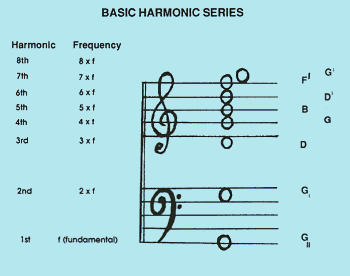 Depending on the original
waveform used, each harmonic will vary in volume or amplitude, and it is
this variation that helps give every instrument its characteristic 'timbre'.
Depending on the original
waveform used, each harmonic will vary in volume or amplitude, and it is
this variation that helps give every instrument its characteristic 'timbre'.
With the exception of a tuning fork all other
objects when struck produce a number of different freqencies as well as the
basic frequency which gives a tone its 'pitch'. In the case of many acoustic
sounds these additional frequencies hear a precise mathematical relationship
to the bass frequency or 'fundamental' frequency. The series of frequencies
produced is known as the harmonic series, with each 'overtone' being a simple
multiple of the 'fundamental' or '1st harmonic'. The basic series is shown
above with a fundamental of frequency of G";
The 'Square Wave' is the simplest wave
to generate from an electrical circuit as it only exists in two states: 'high'
and 'low'. This wave shape produces only the odd harmonics as shown below:
The timbre that this produces is characterised by a mellow sound similar to a clarinet.
The 'Sawtooth Wave' (again named for obvious
reasons) produces all the harmonics in the series, even and odd, and therefore
produces a brighter sound and is a good starting point for brassy
sounds.
The third waveform,the 'Pulse Wave' is
a wave capable of varying its harmonic content depending on the size
of the pulse. In a Square Wave' the two states exist for the same length
of time. If, however, the 'ON' state is shortened with respect to
the 'OFF' state then even harmonics are added starting with 2f and
increasing as the pulse narrows.
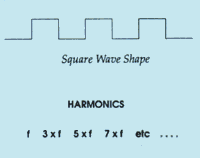
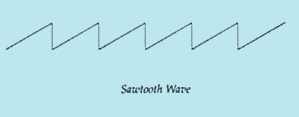
The great use of this comes when the pulse width
is altered during the sound and the harmonic content changes with respect
to time.
With a basic waveform produced the signal now passes on to the filter section.
A filter allows specified frequencies to pass through but cuts out others.
The most common filter used in basic subtractive synthesizers is a low pass
filter which only cuts out frequencies above a certain 'CUT OFF' frequency
which can he set by the user. By taking this filter cut off point far enough
all the harmonics above the fundamental will he lost, producing a sine wave
of the fundamental frequency.

The basic use of a filter is therefore to subtract
harmonics from a wave but most synthesizers include one other main function
which actually boosts a band of frequencies. By feeding back part of the
output signal into the input of the filter the frequencies around the cut
off point are boosted.

As more and more signal is fed back this phenomenon
is exaggerated until the filter breaks into resonance, producing a sine wave
whose frequency is equal to that of the cut-off point set. Creative use of
this
'RESONANCE'
factor can produce exciting
'electronic'
effects.
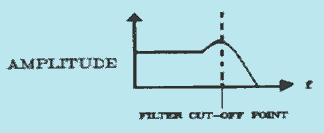
The third area of control in a synthesizer is
that of volume or amplitude. At its simplest level this control enables us
to hear the sound generated. the volume rising immediately to its maximum
when a key or other controller is pressed and falling to zero when released.
Few, if any, acoustic instruments have such a simple and limited volume control
as that. A basic synthesizer therefore offers an
'envelope'
to shape the volume with respect to time.
In fact any of the three elements - Pitch, Timbre
or Volume - can have an envelope. For the present we will consider the effect
of an envelope on volume.
The first control available to the musician relates to how quickly the sound.
once triggered. rises to its maximum volume. A long time would cause the
sound to fade in, rather like a string player slowly increasing the
velocity/pressure of the bow on the string.
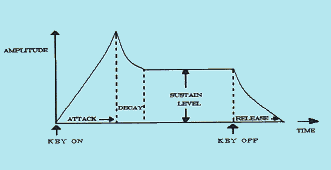 This is known as the 'ATTACK' time. Its converse is the
'RELEASE' time which allows sound to fade out gradually rather than
being cut dead when a key is released. The DECAY time specifies the
time taken for the volume of a sound to drop from its maximum amplitude to
its sustain level while the 'SUSTAIN' level of an envelope determines
the volume of the sound after the initial 'ATTACK'. 'SUSTAIN'
level, once reached, remains constant as long as the key is held. The full
envelope structure is shown below: This type of envelope is known as an ADSR
('ATTACK', 'DECAY', 'SUSTAIN', 'RELEASE'). We now have the three main
areas of control over the sound - 'PITCH', 'TIMBRE' and
'VOLUME'.In the second part of this feature we shall look at how these
music units are brought together in a synthesizer and how each can he controlled
by the signal from a keyboard or other controller.
This is known as the 'ATTACK' time. Its converse is the
'RELEASE' time which allows sound to fade out gradually rather than
being cut dead when a key is released. The DECAY time specifies the
time taken for the volume of a sound to drop from its maximum amplitude to
its sustain level while the 'SUSTAIN' level of an envelope determines
the volume of the sound after the initial 'ATTACK'. 'SUSTAIN'
level, once reached, remains constant as long as the key is held. The full
envelope structure is shown below: This type of envelope is known as an ADSR
('ATTACK', 'DECAY', 'SUSTAIN', 'RELEASE'). We now have the three main
areas of control over the sound - 'PITCH', 'TIMBRE' and
'VOLUME'.In the second part of this feature we shall look at how these
music units are brought together in a synthesizer and how each can he controlled
by the signal from a keyboard or other controller.
Basic Synthesis 1 | Basic Synthesis 2 | Advanced Synthesis 1 | Advanced Synthesis 2| Sampling 1 | Sampling 2
| Chaos | Quantum | Logic | Cosmos | Conscious | Belief | Elect. | Art | Chem. | Maths |